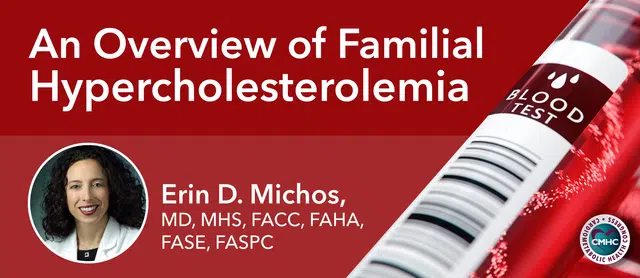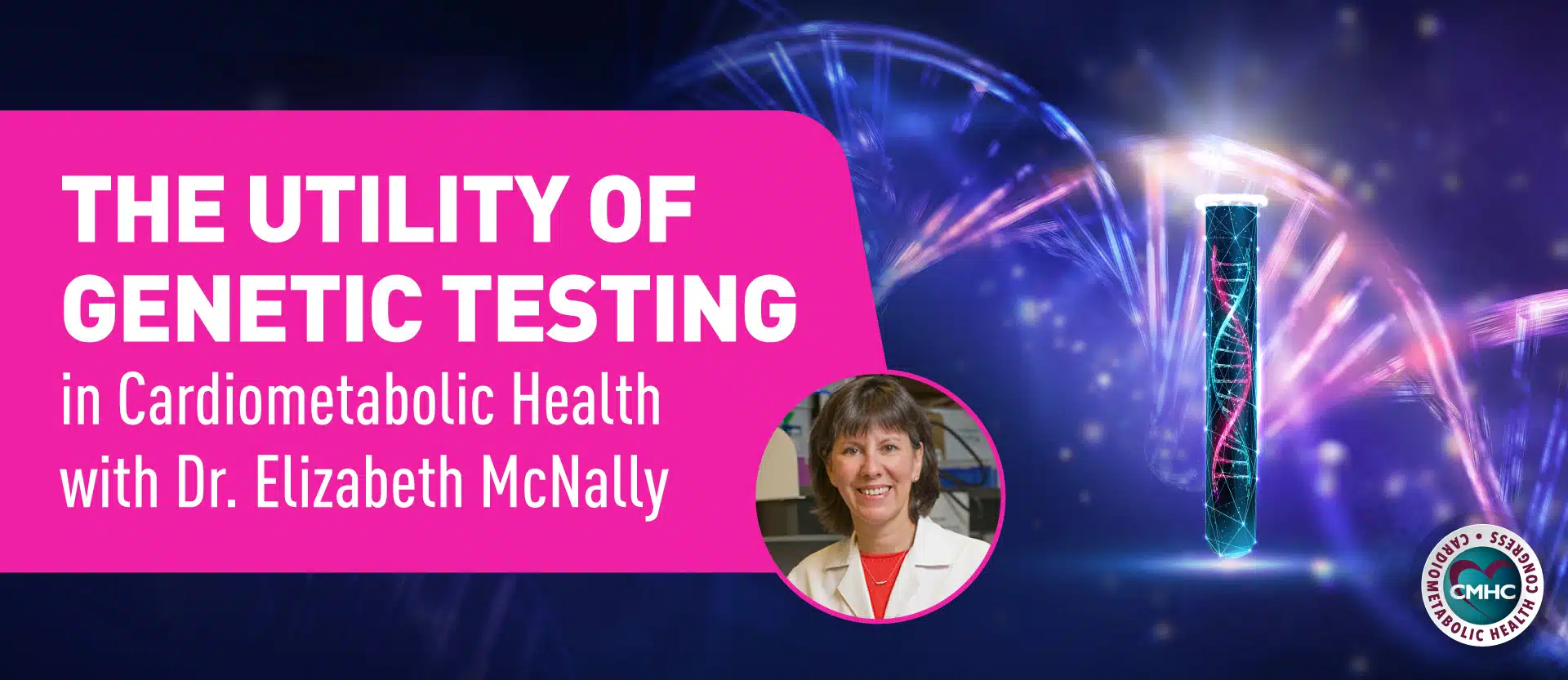During a recent virtual webinar, Cardiometabolic Health Congress faculty member and co-chair of the Women’s Cardiometabolic Health and Wellness Masterclass, Erin D. Michos, MD, took time to discuss familial hypercholesterolemia (FH) and the importance of beginning treatment immediately at diagnosis, even in women who plan to have children.
A relatively common and life-threatening genetic condition, FH is characterized by having high levels of low-density lipoprotein cholesterol (LDL-C) from birth. As many as one in 250 people (about 1.3 million in the U.S. alone) have FH. It is caused by a genetic mutation in one of the genes that clear LDL-C from the body, causing it to accumulate in the bloodstream and eventually build up in the walls of the arteries, leading to heart attacks and strokes in young adults and even children. This differs from acquired high LDL-C, which occurs in individuals over a lifetime of sedentary behavior, tobacco and alcohol use, or consuming a diet high in saturated fat. Another cause of high LDL-C not attributed to FH is in menopausal women when declining estrogen levels (and the hormone’s protective properties) cause a spike in both LDL-C and triglycerides.
Therapeutic urgency
For individuals with acquired high LDL-C due to lifestyle, menopause, or another contributing conditions such as hypothyroidism, obesity, polycystic ovary syndrome, or kidney or liver disease, lifestyle modifications or treating the comorbid condition can help lower LDL-C levels. For people with FH, however, high LDL-C must almost always be treated by targeting the cause of the genetic mutation through pharmacological agents. Another consideration that should increase therapeutic urgency for clinicians is that the length of exposure to high LDL-C is positively correlated to worse outcomes. So, if FH is suspected as the cause of high LDL-C in a young person, delaying treatment is dangerous; despite being young, that patient may have been experiencing the buildup of plaque since childhood and could be at very high risk for heart disease or stroke.
Genetic pathways and targets
Researchers have identified mutations affecting LDL receptor function or the proteins that regulate its metabolism to be the genetic mechanism in FH. Examples are defects in the ApoB gene that impair binding with the LDL receptor, and gain-of-function mutations in the PCSK9 gene that enhance LDL receptor degradation. These mutations lead to low liver uptake of LDL-C and its accumulation in the circulatory system. Most cases of FH are characterized by an autosomal-dominant inheritance pattern of mutations in the LDL receptor, ApoB, or PCSK9 genes, but rare autosomal-recessive genetic causes of FH have been identified, as well those affecting more than one gene (polygenic). This diverse pathogenesis leads to a wide variety of clinical phenotypes in patients with FH, meaning that clinicians need to be aware that a negative genetic test in the three major genes (LDL receptor, ApoB, or PCSK9) does not exclude the presence of FH, and other etiologies should be considered including polygenic causes.
Clinical challenges
Timely and effective treatment for FH is imperative, although the CASCADE-FH study showed that both the diagnosis of FH and initiation of lipid-lowering therapy occur relatively late in life, at median ages of 47 and 39 years, respectively. There is also a problem of clinical inertia and suboptimal LDL-C goal achievement in patients with FH. For example, data from the same CASCADE-FH registry demonstrated that only 77% of patients eligible for lipid-lowering therapy were receiving treatment, and only 39% of those receiving treatment had met their LDL-C goal. In totality, these data highlight the need for earlier diagnosis and improved application of lipid-lowering therapy in order to achieve the necessary reductions in LDL-C.
Special considerations for diagnosing and treating women
Although FH affects men, women and children from every race and ethnicity, it is most underdiagnosed and thus undertreated in women, Black, and Asian patients; these populations are less likely to have their cholesterol levels tested and treated as aggressively as their white male counterparts, for whom lipid-lowering therapy is more typically prescribed. Additionally, gender gaps in FH diagnosis and treatment may be attributed to clinicians hesitancy in implementing testing and pharmacotherapy in young women. Regarding treating cardiovascular risk factors such as FH-related high LDL-C in women of childbearing age, “It’s better to have brief periods of treatment interruption during pregnancy than to leave women untreated for decades during the childbearing years,” said Dr. Michos in her recent CMHC webinar, Lipids in Women Across the Life Cycle with Dr. Erin Michos. But when it comes to initiating the use of LDL-C-lowering agents during pregnancy she cautions “we do have options for pregnant women to lower lipids, but certain ones such as PCSK9 inhibitors we just don’t have enough data to ensure safety in pregnant women.” Unfortunately, that means that finding effective FH treatment for women during pregnancy can be challenging.
Watch the clip of Dr. Michos’ CMHC webinar, below, in which she discusses FH.
How to speak to your patients about FH
Experts recommend driving home four key points to patients who have been diagnosed with (or who are suspected to have) FH. Especially since this genetic disorder is often found in young or asymptomatic individuals, it is important to remind them that FH is:
- Underdiagnosed. Although as many as one in 250 people have FH, only 20% of those know they have it, and many will not be diagnosed until AFTER a significant cardiovascular event such as heart attack or stroke.
- Serious. Left untreated, HF leads to heart attack, coronary heart disease, stroke, and death, even in young people. One in 5 heart attacks in individuals under age 45 is attributed to FH.
- Genetic. Inherited mutations in the LDL receptor, ApoB, PCSK9, and potential unidentified genes affect how the body regulates and removes cholesterol from the bloodstream. Anyone with high LDL-C and a family history of early-onset cardiovascular disease should be counseled about genetic testing, which is the only way to definitively diagnose FH.
- Treatable. When treated, people with FH can live long healthy lives. While healthy lifestyle strategies are important, for individuals with FH they are usually not enough to lower cholesterol to a healthy level. The most commonly prescribed treatments for FH are statins, but additional drugs such as bile acid sequestrants, PCSK9 inhibitors and bempedoic acid, as well as treatment using lipoprotein apheresis can also be used.
Key takeaway
It is important for clinicians to diagnose and implement lipid-lowering treatments in all patients with FH, particularly women of childbearing age. Women who experience adverse cardiovascular or hypertensive complications during pregnancy, especially if they’ve been diagnosed with FH, are at higher risk for those problems returning or worsening later in life.
“It’s imperative that women who experience adverse pregnancy-related cardiovascular complications receive long-term follow-up because these problems will likely not just go away after the baby is born.” – Dr. Michos

















